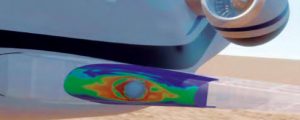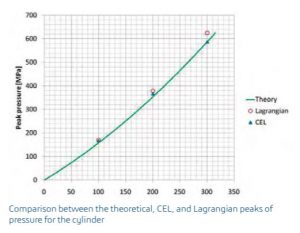This article was originally published in the June 2019 issue of SIMULIA Community News magazine and in the SIMULIA Blog in May 2020.
A bird strike is classified as a high-velocity soft body impact because the stresses, which are generated in the contact region, are significantly greater than the strength of the bird but lower than the strength of the impacted structure. High deformability of the impactor (bird) causes spreading of the impact load over a certain area of the structure that requires the use of special strain-rate-dependent material models.
If the structure is deformable, the impact load depends on the structural response that, in turn, depends on the impact load. Experiments show that bird strike is characterized by the following three phases: (1) shock wave stage; (2) pressure release stage; and (3) steady-state flow pressure stage [1]. Important parameters, which are obtained from the experiments, include the peaks of the impact forces and pressures and the steady flow pressure.

MATERIAL MODELING The bird material is described by the so-called “elastic-plastic hydrodynamic” material model, which is widely accepted in the literature. At high pressures, the hydrodynamic pressurevolume behavior of the bird can be modeled in Abaqus/ Explicit using: (a) the Mie-Grüneisen form of the equations of state with the linear Hugoniot relation between the shock wave in the bird, Us, and the particle velocity, Up, or (b) a tabulated equation of state, which provides greater flexibility in modeling the hydrodynamic response of materials.
Additionally, the Abaqus ductile damage criterion is used to prevent excessive distortion of Lagrangian elements and associated failure of the analysis, which is caused by the anticipated physical behavior (flow) of the water-like homogenized bird, through the deletion of bird elements. Element deletion also brings the results of the simulation closer to reality.
BIRD-STRUCTURE INTERACTION The pressure distributions over the structure with due regard for the nonlinear coupling between the bird and the target can be effectively modeled by means of the general contact capability of Abaqus/Explicit. The penalty method used in the general contact algorithm allows for accounting of the differences in the mechanical properties of the contacting bodies.
APPROACH: LAGRANGIAN OR COUPLED EULERIAN-LAGRANGIAN (CEL) The meshing task is significantly simplified for the CEL approach because there is no need to mesh the soft projectile. Instead, a simple uniform finite element mesh is constructed from Eulerian elements so that the projectile is fully contained within the mesh boundaries throughout the analysis. This can be achieved either by creating an immovable Eulerian mesh, which is large enough to encompass the entire trajectory of the projectile from the beginning to the end of the analysis, or by creating a moving Eulerian mesh, which is capable of following, expanding, and contracting to enclose the projectile as it moves in space.
RESULTS The use of a cylindrical projectile permits a direct comparison with the analytical predictions of the pressure peaks and steady flow pressures. Good correlation is observed between Abaqus and theoretical values, for both the Lagrangian and CEL methods.

CONCLUSIONS The validated Abaqus soft projectile models can be directly used to analyze a given structure/structural part without having to perform a complicated and time-consuming calibration task. All the models described herein are available from SIMULIA in the Abaqus model data base format. The user needs only to substitute the rigid target in these data bases with the structure to be analyzed and run the analysis.
FOR MORE INFORMATION Detailed results can be found in the complete Best Practices document.
SIMULIA offers an advanced simulation product portfolio, including Abaqus, Isight, fe-safe, Tosca, Simpoe-Mold, SIMPACK, CST Studio Suite, XFlow, PowerFLOW and more. The SIMULIA Community is the place to find the latest resources for SIMULIA software and to collaborate with other users. The key that unlocks the door of innovative thinking and knowledge building, the SIMULIA Community provides you with the tools you need to expand your knowledge, whenever and wherever.


